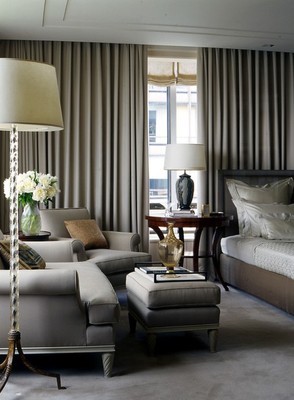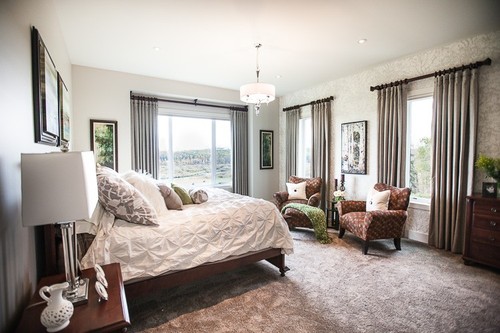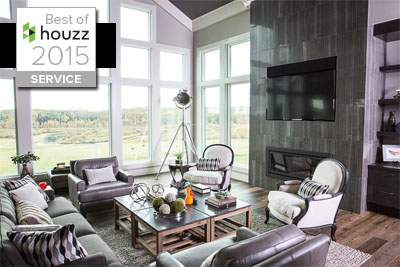At one time or another, most of us have suffered from insomnia. We all know that lack of sleep affects health and concentration. But before you take that sleeping pill, why not try a bedroom makeover?
Correct interior design can transform your bedroom into a sanctuary and help you get a proper night’s rest. As an interior design professional, the goal is to ensure that this room is not only beautiful but also supports rest, relaxation and lovely sleep.
Here are my Top 5 Tips to create a stunning space for slumber:
1) Keep the Bedroom Dark and Cool
It is important that your bedroom is kept dark. Studies have shown that even dim light in bedrooms can be linked to weight gain, depression, reduced cognitive function and physical illness.
Blackening out your bedroom with proper window treatments, such as blinds, eliminates light and creates a cave-like atmosphere. One client complained that blackout blinds alone allowed some light to seep through. This was most irritating in the summer months when days are longer and the sun rises much earlier. I suggested the use of a combination of blackout blinds/shades plus blackout lined side panels to eliminate any daylight, moonlight or street light from creeping in. Another option is to install ceiling-to-floor-length blackout lined drapery that can be drawn across windows.
Eliminate all “blue” light – this includes LED alarm clocks or nightlights, tablets, phones, computers or TV. Studies suggest that the use of red or amber LED nightlights is preferred because those colours don’t disrupt circadian rhythms the way blue light does.
A room temperature of about 65 degrees Fahrenheit at night helps keep you cooler and is optimal for best quality of sleep and health.
2) Sensory Design for Sleep
Here are six sensory related items to consider when designing your bedroom for a proper night’s sleep:
1. Color can be used to make a bedroom more relaxing, aiding a better night’s sleep. Avoid using saturated deep reds, oranges and yellows as these actually increase your anxiety or energy. You want to relax and prepare for a good night’s rest so use cooler colour palettes such as sage green or “spa” like blues. These colours are psychologically considered to inspire feelings of tranquility, relaxation and calm.
2. Lighting should be amber coloured to create a more relaxing mood before bed. Use soft lighting with side bed lamps which can adjust lighting levels. Yellow or amber coloured bulbs nurture a more soothing feeling than brighter fluorescent or LED bulbs.
3. Visual use of textures and patterns can be more complex in the bedroom. The use of organic/natural materials such as wood and silk is a stress-reducer. This would also include wallpapers with elements such as grass or patterns inspired by nature.
4. Bed linens are in contact with our skin during our entire sleep. Snuggle under the exquisite and luxurious feel of Giza Egyptian cotton bedding to draw you deep into your bed and slumber.
5. Reduce Noise. Bedrooms should be fairly quiet. Loud noises at 35 decibels and higher can increase blood pressure even if they do not wake you. Sounds like airplanes, trains and snoring are disturbing. Evidence shows that we don’t get used to loud noises while asleep. Exposure to consistently loud traffic noise is associated with higher risk of heart attacks. One solution is to install ceiling to floor drapery that is not only blackout lined, but has an additional insulated lining (a thick flannel type of fabric) between the fabric and outer blackout lining. Install an additional sound absorbing blind (such as a honeycomb shade) in the window behind your front drapery. The combination of the insulating drapery and shade help deaden incoming sound. Soundscaping your bedroom using elements of nature reminds us of pleasant and relaxing experiences. Helpful sound examples are waves breaking on the beach or a breeze rustling through the leaves during a walk through the woods.
6. Pleasing Scents can aid relaxation, reduce anxiety and improve sleep. Sweet smells like strawberries are associated with happiness and well-being. The scent of roses helps encourage more emotionally positive dreams. Vanilla and floral scents reduce anxiety. Lemon, oranges and lavender are all relaxing and Ylang Ylang is calming. Smelling Jasmine during slumber has an additional effect that can last into the following day. Studies have shown that smelling Jasmine while asleep increases concentration and alertness well into the hours of the following afternoon.
3) Rearrange Your Furniture
The way you place furniture in the bedroom can positively affect the quality of your sleep. Where you place your bed can affect how comfortable or relaxed you feel. Many clients feel safer and more secure placing their beds so that they can view the door. If at all possible, the bed should not be placed under a window as this may produce a sub-conscious feeling of insecurity.
4) Architectural Design Lower ceilings and dimmer lighting feel soothing and provide refuge. If the ceiling is high, a canopy bed is a good way to provide a cosy, protected atmosphere. In the bedroom, smaller windows are a better choice for privacy and security. For people who have issues sleeping together because of one partner’s snoring or being restless through the night, a separate bedroom connected with a shared master bath is a great solution, if feasible. These are sometimes called snore rooms and are beginning to be incorporated in 55+ living environments.
5) Clear the Clutter
Proper sleep is not just related to the design of the bedroom. Your work environment also has physical and psychological impacts. Put things in their proper place. Clear the clutter both in the bedroom and other spaces in the home. Logically, a spacious, quiet and clean office will lessen irritations, improve concentration, plus reduce stress and bacteria that can cause illness. How your work environment is designed carries over to life at home by influencing sleep quality. Research shows that working near windows during the day is linked to longer nighttime sleep. More natural light exposure at work results in longer sleep duration, better quality of sleep, and an overall improved quality of life.
Simply by applying these design ideas and carefully selecting the proper materials, furnishings and lighting you can create a healthy and restful bedroom – not just for sleep but a safe haven to relax, reflect and rejuvenate.
Ellen Walker Design is an award winning full service interior design firm, specializing in both residential and commercial projects with a focus on supporting health, wellness and sustainable design. Ellen has appeared several times on CTV and Alberta Primetime.
Website: EllenWalkerDesign.com
Phone: (587) 802-0977








